‘For her sole and separate use’
Published in 20th Century Social Perspectives, 20th-century / Contemporary History, Features, Issue 5 (Sep/Oct 2006), Volume 14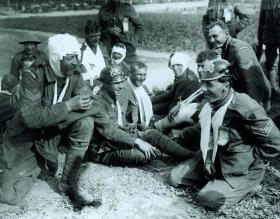
Wounded British troops wearing German helmets at Heilly, September 1916. (Imperial War Museum)
Why did they enlist?
Motivation varied from the personal—restlessness, a thirst for adventure or a wish to see more of the world—to a belief that it was the right thing to do, a patriotic duty. Some certainly believed that they were fighting a just war, a war to protect small nations, and in particular listened to those bishops calling for men to fight to defend ‘poor little Catholic Belgium’. Others listened to the politicians, both unionist and nationalist, like Edward Carson and John Redmond, who were playing a more complicated political game. They believed that by assisting Britain now their party and supporters would reap benefits later. By calling on their supporters to enlist, unionists could demonstrate how quickly and loyally they served their king, while nationalists could demonstrate that a more independent Ireland could still align itself with Britain. Both sides were prepared to sacrifice the lives of tens of thousands of men to prove these points. Economic motives to join armies have existed since the beginning of time. A steady wage was a strong incentive to enlist, especially when work was scarce and there were families to feed. We shall never know exactly why men joined up; it was probably a combination of some or all of the above.
Two categories: informal and nuncupative
There is one large body of documents in the National Archives of Ireland (NAI), however, which may reveal much information about the men, including their social as well as their geographical backgrounds. These papers, over 9,000 in total, are the wills of soldiers who died in World War I.
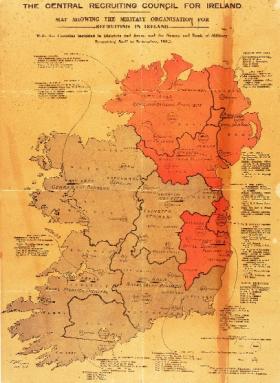
Map showing the areas in which the British Army’s Irish regiments recruited in the early stages of World War I. (National Museum of Ireland)
The wills fall into two categories: informal wills and nuncupative or missing wills. The informal wills were written during the war in soldiers’ pay books. Soldiers were not obliged by the British Army to write a will before they went to the front, although as World War I progressed there was increasing pressure on officers to ensure that wills were written. By World War I, in the back of the soldiers’ pay books there was a form called ‘short form of will’. The majority of wills in the collection are of the various types of short form of will, which changed in design through the years. Missing or nuncupative wills contain evidence of the soldiers’ wishes, either gathered from sworn testimonies by relatives and witnessed by a justice of the peace or member of the clergy, or expressed in letters actually written by the soldier. These wills were never for soldiers higher in rank than non-commissioned officers —sergeants, gunners, riflemen and privates but no officers. They are also the wills of any soldier who gave his domicile as Irish when enlisting.
The wills are stored in acid-free boxes in the National Archives of Ireland, Bishop Street, Dublin, with between 250 and 300 wills per box. They are arranged alphabetically in the batches in which they were processed, normally three months after the soldiers’ deaths, when the War Office had the information to coordinate the tallies of the numbers of the dead from the regiments and process the relevant wills. In 1916, and in particular during the four-and-a-half-month Battle of the Somme, many wills of soldiers who died on the western front seem to have been processed very quickly, merely noting where they died and when, the details synopsised to ‘killed in action in France or Belgium’. Other records might name a casualty clearing station, or a military hospital or asylum such as Fareham; in a rare example, the will of Pte Irvine Brown of the 8th Battalion Royal Inniskilling Fusiliers specifies a death of ‘gas poisoning received in action France’ on 29 April 1916. Amongst the records for 1916 there are the wills of soldiers who had been missing since the aborted invasion at Gallipoli in 1915, and whose affairs were finally being legalised as all hope of their survival had faded.
Soldiers from the slums
From a sample analysis of the wills of soldiers from Dublin who died during 1916, from a city with one of the highest ratios of eligible men enlisting in World War I, some interesting socio-economic information comes to light. In one box of 263 wills, 56 belong to soldiers either born or living in the county of Dublin, and 36 of those from County Dublin are from the city, between the Royal and Grand Canals. Dublin at this stage was geographically a small city, and one which had a very high concentration of population. At the outbreak of World War I, Dublin had the worst urban housing in the United Kingdom, with 20,108 families living in one-room accommodation in tenements in the city. The addresses on the wills from the city of Dublin are from what were notorious slum areas at that time, including Benburb Street, Queen Street, Upper Dorset Street and the Liberties. The soldiers from the city of Dublin whose wills are in the National Archives came from these tough working-class areas, where poverty ruled supreme.
It is also possible to analyse the family background of the soldiers, information not always shown in the records of the Commonwealth War Graves Commission and the
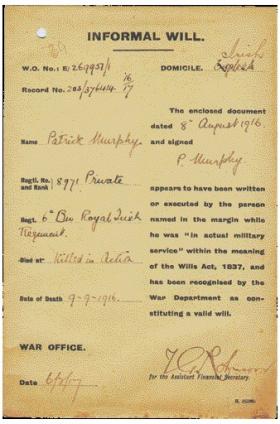
The informal will of Pte Patrick Murphy, Royal Irish Regiment. (National Museum of Ireland)
Cost of living
The contribution of the separation allowance for the wives of soldiers and other voluntary donations from soldiers’ wages would appear to have had a significant effect upon a family’s finances. Many labourers, if they could find work, only earned between 15 and 18 shillings per week. The cheapest pound of bacon to be bought in Dublin was 5d or 6d, too expensive for most people in tenement areas, many of whom lived on a diet of tea and bread. In those poverty-stricken times the separation allowances given to the wives of soldiers meant a lot. Letters written by soldiers to their families and accepted as nuncupative wills, also mention leaving various amounts to female relatives, from the aunts who got 6d per day to one mother who got 15 shillings per month while her son was at the front. The soldiers were very aware of the importance of this income to the women, and occasionally in a will where wages saved and owed were being left to married female relatives the phrase ‘for her sole and separate use’ is used to clarify their wishes that these female relatives alone use the money being willed to them. For example, Sergeant Joseph Byrne from Dublin, who died on the first day of the Somme, specifically used this phrase—‘for her sole and separate use’—in order to ensure that his sister Elizabeth Burke would definitely inherit his monies.
From letters accepted in lieu of wills it becomes apparent that soldiers were concerned that female relatives should not think that they were forgotten about financially, as this extract from the will of Pte James Nimmo, 2nd Bn Connaught Rangers, shows:
‘PS Mother about not leaving you so much a week. Well it’s like this it was the way I was tricked their was a cpl in the Drums and he went round the room asking if we were leaving anything to our people so I gave him my name leaving you 15 shillings a month. So did all the other drummers but to our surprise after we were in France he told us he was only joking. So that is how you didn’t get it but you have it all to come if anything should happen so don’t think I forgot about you, never. Good bye for the present.’
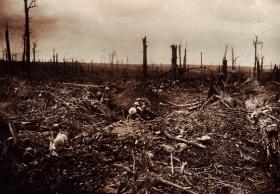
Delville Wood, Battle of the Somme, 1916. (National Museum of Ireland)
Shadow of the 1913 Lockout
Many Dubliners experienced very hard times during and after the Lockout of 1913, which had dragged on until February 1914. After the strikes, some men who were blacklisted by employers never subsequently got work in Dublin. In addition, it took some industries time to recover from the strike and therefore they were not hiring as many employees. The army could have looked like a good prospect for these men, who were of course expecting the war to be over by Christmas 1914. The 2nd Royal Dublin Fusiliers, a regular battalion, while in France at the second Battle of Ypres in 1915 reportedly raised three cheers for Jim Larkin. Other battalions also attracted groups of working men: one of the companies of the 7th Royal Dublin Fusiliers were a group of Dublin dockers who were even nicknamed ‘the Larkinites’. Indeed, records show that 2,700 Irish Trade and General Workers Union members, men who probably would have been involved in the Lockout, were at the front fighting during 1916.
Another will from an earlier part of the collection in 1915 also shows links to trade unions in Dublin. Pte William McSweeney of the 1st Battalion Royal Dublin Fusiliers died on 23 October 1915 in Gallipoli at the age of 23. William, the son of Mary McSweeny of 7 Summerhill, Dublin, had not left a will, so his family needed a sworn testimony as to his wishes which could stand as a nuncupative will. There is a testament stating that William always said that his mother would inherit his effects, and it is signed by ‘John S. Kelly TC Manager & County Secretary, The Irish RWTU’. Kelly states: ‘These people are very humble and are not able to answer all the questions’. John Saturnus Kelly was the leader of the short-lived Rail Workers’ Trade Union (RWTU), which had a brief existence during the 1913 Lockout. It was not a union recognised by James Larkin; indeed, Kelly was the publisher of two newspapers that frequently attacked Larkin. But Kelly had some links with John Redmond, who advised the Irish Volunteers to enlist, and could therefore have been seen by the family as someone who would ‘represent them’ and whom they trusted.
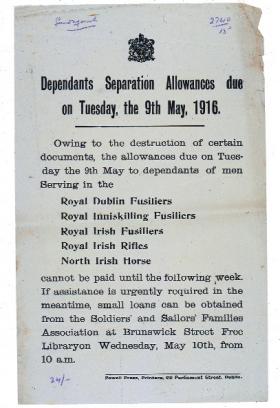
Notice concerning dependants’ separation allowances, disrupted by the Easter Rising. (National Museum of Ireland)
Alternative sources
Further analysis of soldiers’ addresses may show patterns of enlistment from certain streets and areas in the city. Already, amongst the small selection of Dublin wills, two of the wives were neighbours on Queen Street, while the wife and mother of two different soldiers lived on Bridge Street. Interestingly, some of the soldiers whose wills are in the NAI are not mentioned in either the Commonwealth War Graves Commission or the County Dublin Book of the Dead, despite the fact that the War Office listed them as dead. Indeed, six of the soldiers are not mentioned in either list, over half the soldiers have not had their address listed, and 23 per cent of the soldiers who were, according to wills written by themselves, married are not mentioned as being married on either list. Hence, while it appears from looking at the normal reference lists that these soldiers are all young unmarried men, this is evidently not the case. On the other hand, comparisons between the three sources show that some of the wives changed address in these years, and some would remarry—indeed, one emigrated to Liverpool and remarried in the years after the war. Although there is evidence that soldiers’ wives and soldiers’ families moved during the four years of the war, the census of 1911, and even 1901, could also yield further insights into the soldiers’ socio-economic backgrounds. For example, Margaret and Mary, the sisters of Pte Christopher Storey, 1st Bn Royal Dublin Fusiliers, who died at Gallipoli, lived at 11 Benburb Street, a tenement listed in the 1901 census and where many retired soldiers lived.
Not just in the Royal Dublin Fusiliers
The wills also demonstrate that the soldiers from these poorer areas did not belong to just one regiment. Indeed, one of the two soldiers’ wives living on Queen Street was married to a soldier in the regular battalion of the Royal Inniskilling Fusiliers, and one of the two soldiers from Bridge Street was in the Leinster Regiment. Sixteen out of the 36 men from between the canals served in regiments other than the Royal Dublin Fusiliers. Just as any one regiment could be made up of people from any region of the United Kingdom, the wills demonstrate that any one region could have men serving in a large variety of regiments. In fact, the sixteen served in twelve different battalions, representing eight different Irish regiments. None served in English regiments, although other soldiers at the same time, but who were not from the county of Dublin, did.
Normally, if a soldier enlisted before the start of the war, by 1916 he would still be in the regiment in which he enlisted. Only a quarter of the sixteen were serving in non-regular battalions of other regiments. There were two regular battalions, the 1st and 2nd, per regiment, e.g. the 1st and 2nd Battalions of the Royal Munster Fusiliers regiment. Non-regular battalions were formed during wartime, so as a high proportion of these soldiers were serving in regular battalions it is likely that they enlisted before the outbreak of the war. There is evidence that at least one of the sixteen was a reserve when called up, a soldier previously serving with the Connaught Rangers who then served with the Munster Fusiliers. This, along with such nicknames as ‘the Larkinites’ for the company in the 2nd Dublin Fusiliers, meant that there was a spread of men from the inner city serving in regular battalions. From one street alone, then, there could be soldiers who had been serving since before World War I, in other battalions not normally located in a region, and newly enlisted volunteers serving in a variety of battalions and regiments.
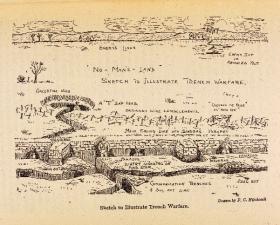
Sketch to illustrate trench warfare. (National Museum of Ireland)
Other reasons for enlisting
The soldiers’ thoughts about the war they were fighting and the reasons they fought can be found in some of the letters taken as nuncupative wills. Some soldiers were certainly thinking of the larger political picture. Take, for example, the motives of Edward Meehan of the 2nd Bn Royal Irish Rifles, in his letter written on the day they got the news that they were heading for France on 12 August 1914:
‘There is great excitement here with the movements of thousands of troops everyone seems to be anxious to get at the Germans. I felt that my heart is as big as a mountain. I fell [sic] that it is my duty to go to help to put down such beasts as the Germans are.’
Meehan, who was presumed dead from 26 October 1914, wrote this letter before he reached the front. One English soldier’s will, however, which had been gathered into this collection by mistake, advises his mother thus in August 1914: ‘all (I) have to say now Mother is to keep Pat & Con out of the service’, meaning the armed services. But Michael Foley of the 2nd Bn Royal Munster Fusiliers, who is assumed to have died south-west of Lieven on 21 June 1916, wrote in the back of his pay book that he was fighting ‘for my faith, country & (to) do my duty as an Irishman’. None of these soldiers are from Dublin; in fact, frustratingly, to date I have not come across any such thoughts written by the Dublin soldiers, though these letters do represent the thoughts of some of the working-class men who fought in the Irish regiments.
To date it has usually been the officers whose letters and ideas have been used to sum up the thoughts of those who fought in World War I. The wills of these ordinary soldiers are a valuable contemporary set of documents written by the rank and file. The wills deserve further analysis to give us a proper insight into the background and thoughts of those Irishmen who enlisted, fought and died in the Great War.
Siobhán Pierce is a curator of the forthcoming military history exhibition at the National Museum of Ireland, Collins Barracks.

An armoured car and wounded on stretchers waiting to be evacuated from Guilemont, September 1916. (Imperial War Museum)
Further reading:
A. Gregory and Senia Paseta (eds), Ireland and the Great War: ‘a war to unite us all’? (Manchester, 2002).
K. Jeffery, Ireland and the Great War (Cambridge, 2000).
T. Johnstone, Orange, green and khaki: the story of the Irish regiments in the Great War 1914–18 (Dublin, 1992).
J. Prunty, Dublin slums 1800–1925: a study in urban geography (Dublin, 1998).
















